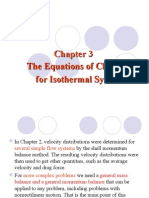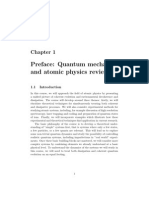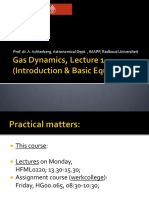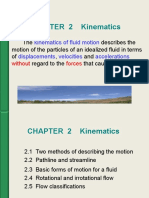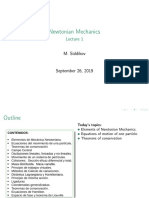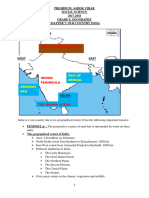Lecture Notes
Lecture Notes
Uploaded by
mohamed farmaanCopyright:
Available Formats
Lecture Notes
Lecture Notes
Uploaded by
mohamed farmaanOriginal Title
Copyright
Available Formats
Share this document
Did you find this document useful?
Is this content inappropriate?
Copyright:
Available Formats
Lecture Notes
Lecture Notes
Uploaded by
mohamed farmaanCopyright:
Available Formats
partial regularities of suitable weak solution of Navier Stokes Equation
Notes:
- discuss and study the trajetory of the liquid with the basic physical parameters
initializing the fluid for defining the equation. (Introduction
from lecture).
- Every factor of equation in existense is finite in nature within
the defined limit.
Navier Stokes Equation:
- Gurmewan (Mathematical Principle)
- Every fluid comes into action unless or until the fluid is instigated
by an external force from the prescribed system. (The initial velocity of motion of
the fluid is as a result of the external medium of mechanism that instigates the
motion)
- FLuid becomes less precise to study as it becomes more unsteady
- utilize the average laws to small physical domains to transform them into
differential equations.
- Equations balance the internal forces with acceleration.
- Langragian and Eulerian coordinates serve as interfering factor in NS equation
- Langragian Coordinate Model: The data of each particle is recorded at various
point in a system space
- Eulerian model: The data of each particle is recorded at a particular point in a
system space when the particle is passing through the particular point.
- Mostly the velocity vector of the particle in space in recorded.
- Fluid volume cannot be reduced.
- Langragian Coordinate: The parcel fluid in a system will always be the same
(incompressible) in a system space
-Eulerian Coordinate: The volume of fluid is not a primary factor rather the vector
flow of the fluid through a particular region is considered.
- Langragian:
det(dY/dx) = 1; x= position in space @ time 't'
- Eulerian Model:
div(V') = 0; V'= vector of the fluid
- accelertion is a langragian parameter as the particle in itself is looked at to
define the physics.
- acceleration in a Eulerian Co-od is non linear as two medium of points (one at
the particular point x in space and a point after x required for determining an
equation). The fluid particle in a eulerian co-od results in a 2 velocity field
that results in a non-linear equation.
lim<h->0){(V'(x+hV',t+h)-V'(x,t))/h}
=> a(x,t)= V'(x,t)+V'.(d2v/dx2)
- in the navier stokes equation the eulerian cood has dynamic constants which makes
it non-linear.
- presure and velocity are instantaenous in compressible flow without attenutation
(time delay)
- a(fluid)= -dP/dt (acceleration of fluid increases with instantaneous increase in
pressure (negative pressure))
- viscosity of the fluid plays an important role as the static particle are
influenced to motion by the fluid in motion surrounding it.
- viscosity is a quadratic effect (non-linear effect) of a velocity field.
- Laplacian of the velcity field of a particle= (average velocity of assumed region
around the point minus the velocty at the point)/ square of the radius of the
assumed ring region around the point.
- Navier Stokes Equation is usually written in Eulerian coordinate as a result of
this phenomenon.
a'= v(t) +V'.dV'=-dp+dell.V'
Option 1: (Solution for Navier Stokes Equation)
- An initial velocty field and the initial condition are given, the solution that
feeds finite and coherentsolution for all the parameters of the NS equation must be
satisfied.
Option 2: (A solution that blows up at finite time)
- A solution with the aid of initial data where the velocity field becomes infinity
at finite time.
Clue:
Weak Solution fluctates from nice over a period of time.
You might also like
- Transport Phenomena Chapter 3Document62 pagesTransport Phenomena Chapter 3bima0407No ratings yet
- MIT 8.421 NotesDocument285 pagesMIT 8.421 NotesLucille Ford100% (1)
- KPI and Supplier Performance Scorecard Tool Appendix 6Document7 pagesKPI and Supplier Performance Scorecard Tool Appendix 6Nkem Joseph-Palmer100% (2)
- Prof. Dr. A. Achterberg, Astronomical Dept., IMAPP, Radboud UniversiteitDocument37 pagesProf. Dr. A. Achterberg, Astronomical Dept., IMAPP, Radboud UniversiteitEnrique FloresNo ratings yet
- Momentum Equation in Cartesian Co-Ordinate System and Bernoulli's EquationDocument5 pagesMomentum Equation in Cartesian Co-Ordinate System and Bernoulli's EquationArup SheeNo ratings yet
- AdvHyd02 - 2020 OLC NotesDocument28 pagesAdvHyd02 - 2020 OLC NotesAhmad Khairi Abd WahabNo ratings yet
- Navier Stokes EquationsDocument9 pagesNavier Stokes EquationsMalvin NaickerNo ratings yet
- FM 4 Fluid Kinematics CompleteDocument48 pagesFM 4 Fluid Kinematics Completeالياس يونس مرغلانيNo ratings yet
- Notes For Weeks 5-9 ENGG1800Document6 pagesNotes For Weeks 5-9 ENGG1800Rebecca MorrisNo ratings yet
- Chapter One Basic Concepts From Fluid Dynamics and Thermodynamics 1.1 Definitions - Gas DynamicsDocument5 pagesChapter One Basic Concepts From Fluid Dynamics and Thermodynamics 1.1 Definitions - Gas DynamicsHaider SalmanNo ratings yet
- Introduction To Fluid DynamicsDocument76 pagesIntroduction To Fluid DynamicsRajrdb100% (1)
- Navier-Stokes Equations - ReviewDocument38 pagesNavier-Stokes Equations - Reviewutterly small thingsNo ratings yet
- Differential Relations For A Fluid ParticleDocument71 pagesDifferential Relations For A Fluid ParticleMaha D NugrohoNo ratings yet
- Chaotic Dynamics of A Harmonically Excited Spring-Pendulum System With Internal ResonanceDocument19 pagesChaotic Dynamics of A Harmonically Excited Spring-Pendulum System With Internal Resonancechandan_j4uNo ratings yet
- CHAPTER 2 Kinematics: Kinematics of Fluid Motion Displacements Velocities AccelerationsDocument72 pagesCHAPTER 2 Kinematics: Kinematics of Fluid Motion Displacements Velocities AccelerationsNaresh SuwalNo ratings yet
- Numerical Limitations of Hydraulic Models: L. Toombes and H. ChansonDocument8 pagesNumerical Limitations of Hydraulic Models: L. Toombes and H. Chansoncardosso100% (1)
- Lecture 3 - Conservation Equations Applied Computational Fluid DynamicsDocument33 pagesLecture 3 - Conservation Equations Applied Computational Fluid DynamicsPragadeesh MohanNo ratings yet
- Modeling, Simulating and Rendering Fluids: Thanks To Ron Fediw Et Al, Jos Stam, Henrik Jensen, RyanDocument47 pagesModeling, Simulating and Rendering Fluids: Thanks To Ron Fediw Et Al, Jos Stam, Henrik Jensen, RyanvdertiNo ratings yet
- Chapter 4 1 Fluid KinematicsDocument19 pagesChapter 4 1 Fluid Kinematicsراكان حربيNo ratings yet
- 1 - Introduction in Dynamical SystemDocument45 pages1 - Introduction in Dynamical SystemMaria ClaytonNo ratings yet
- Dynamical Systems and Chaos: CAS Spring 2008Document31 pagesDynamical Systems and Chaos: CAS Spring 2008Kasra ManiNo ratings yet
- Governing Equations of Fluid Dynamics: Dr. Zaib AliDocument70 pagesGoverning Equations of Fluid Dynamics: Dr. Zaib AliHasnain MurtazaNo ratings yet
- Fluid KinematicsDocument24 pagesFluid KinematicsMohammad Zunaied Bin Harun, Lecturer , CEENo ratings yet
- Governing Equation For Fluid MotionDocument47 pagesGoverning Equation For Fluid MotionRAHUL100% (1)
- Basic Conservation Laws PDFDocument12 pagesBasic Conservation Laws PDFAbid RanaNo ratings yet
- Defenitions Physics LecDocument11 pagesDefenitions Physics Lecjennyvargas1222No ratings yet
- Two-Phase Flow ModelingDocument388 pagesTwo-Phase Flow Modelingاحمد جاسم شكاره100% (2)
- Problems For Module 2-3-4 TheoryDocument9 pagesProblems For Module 2-3-4 TheoryQuynh NhuNo ratings yet
- Chapter 2: Motion in One Dimension: X, AvgDocument4 pagesChapter 2: Motion in One Dimension: X, AvgAnu RaoNo ratings yet
- 2019 P PHY Module 1 4 Prelim Notes Zoe PryorDocument14 pages2019 P PHY Module 1 4 Prelim Notes Zoe PryorMohammed NiloyNo ratings yet
- Quantum PhysicsDocument17 pagesQuantum PhysicsAgnivesh SharmaNo ratings yet
- Chapter 1 GreatfunDocument70 pagesChapter 1 GreatfunTaimoor KhanNo ratings yet
- 2.1. Introductions To HydrodynamicsDocument8 pages2.1. Introductions To HydrodynamicsRaul IlieșNo ratings yet
- Anna University Examinations, Dec. 2014 B.Tech - Chemical Engineering Ch2402 - Transport PhenomenaDocument18 pagesAnna University Examinations, Dec. 2014 B.Tech - Chemical Engineering Ch2402 - Transport Phenomenajeevanantham 5846No ratings yet
- Chapter-3 Fluid DynamicsDocument51 pagesChapter-3 Fluid DynamicsS.M Umer SiddiquiNo ratings yet
- Chapter 2Document27 pagesChapter 2hailegebreselassie24No ratings yet
- Lecture - 1 - Eqn of Continuity - UPDATED PDFDocument10 pagesLecture - 1 - Eqn of Continuity - UPDATED PDFShanmukShannuNo ratings yet
- Mechanical Vibrations Week 1Document57 pagesMechanical Vibrations Week 1mrb87No ratings yet
- Finals ReviewerDocument24 pagesFinals ReviewerAdrian SalvoNo ratings yet
- 2 ABM SlidesDocument2 pages2 ABM Slides乔GeorgeNo ratings yet
- The Schrödinger Equation: A Detailed ExplanationDocument2 pagesThe Schrödinger Equation: A Detailed ExplanationleoregisterNo ratings yet
- Chaos PresentationDocument26 pagesChaos PresentationSiana Alinda AniseNo ratings yet
- Angular Momentum 1Document29 pagesAngular Momentum 1Atif ImamNo ratings yet
- Lecture 5Document30 pagesLecture 5Anonymous fSLJC1No ratings yet
- Chapter-12 Kinematics of A ParticleDocument16 pagesChapter-12 Kinematics of A ParticlehamzaNo ratings yet
- Rbanci Freportfa11 PDFDocument17 pagesRbanci Freportfa11 PDFMuhammad FahimNo ratings yet
- Fluid04 ZBDocument42 pagesFluid04 ZBZain MustafaNo ratings yet
- MAM1043H Second Semester NotesDocument28 pagesMAM1043H Second Semester Notesrayraymamabolo2004No ratings yet
- Lecture 13 - Chap 3Document15 pagesLecture 13 - Chap 3abdulsubhanali7No ratings yet
- 3.1 Kinematics of Fluid FlowDocument54 pages3.1 Kinematics of Fluid FlowItsubdink BoruNo ratings yet
- Fluids Ebook - Linear Momentum EquationDocument3 pagesFluids Ebook - Linear Momentum EquationYim Hoe YenNo ratings yet
- Dynamics of A Mass-Spring-Pendulum System With Vastly Different FrequenciesDocument6 pagesDynamics of A Mass-Spring-Pendulum System With Vastly Different FrequenciesvertugoNo ratings yet
- In Engineering, Analytical Approach Is Time Consuming, Very Specific and Not Always Applicable. Even Harder For The Biomedical EngineeringDocument23 pagesIn Engineering, Analytical Approach Is Time Consuming, Very Specific and Not Always Applicable. Even Harder For The Biomedical EngineeringGunes UzerNo ratings yet
- Fluid Mechanics IIDocument18 pagesFluid Mechanics IIYousef FarajNo ratings yet
- Lecture5-Kinematic FlowsDocument30 pagesLecture5-Kinematic FlowszaorezmuhammadNo ratings yet
- Lagrange Equation 1Document32 pagesLagrange Equation 1Gthulasi78No ratings yet
- Slides For Chapter 4 FM1 2023-24Document88 pagesSlides For Chapter 4 FM1 2023-24ABDUL WAHABNo ratings yet
- Lecture 1Document24 pagesLecture 1Jarom SaavedraNo ratings yet
- Chapter 4Document23 pagesChapter 4syedmuhammadtariqueNo ratings yet
- Velocity Moments: Capturing the Dynamics: Insights into Computer VisionFrom EverandVelocity Moments: Capturing the Dynamics: Insights into Computer VisionNo ratings yet
- Maria1Document2 pagesMaria1mohamed farmaanNo ratings yet
- Existence and Smoothness of The Navier-Stokes Equation in Two and Three Dimensional Euclidean PlaneDocument8 pagesExistence and Smoothness of The Navier-Stokes Equation in Two and Three Dimensional Euclidean Planemohamed farmaanNo ratings yet
- Effect of Leading-Edge Protuberances On Unsteady ADocument14 pagesEffect of Leading-Edge Protuberances On Unsteady Amohamed farmaanNo ratings yet
- Clinic Standards - Revised04 12 10Document1 pageClinic Standards - Revised04 12 10mohamed farmaanNo ratings yet
- Modulated Taylor-Couette FlowDocument35 pagesModulated Taylor-Couette Flowmohamed farmaanNo ratings yet
- Meshing Volume 3Document330 pagesMeshing Volume 3mohamed farmaanNo ratings yet
- German Adjective ListDocument24 pagesGerman Adjective Listmohamed farmaanNo ratings yet
- Design of Wing Model For Flutter Analysis: January 2022Document8 pagesDesign of Wing Model For Flutter Analysis: January 2022mohamed farmaanNo ratings yet
- Kalagobe MECN3007Document30 pagesKalagobe MECN3007mohamed farmaanNo ratings yet
- Cavalcanteetal 2011Document11 pagesCavalcanteetal 2011mohamed farmaanNo ratings yet
- Singh 2012Document11 pagesSingh 2012mohamed farmaanNo ratings yet
- PVSC 2018 1026Document8 pagesPVSC 2018 1026mohamed farmaanNo ratings yet
- United Arab Emirates - Middle East - RE - SPDocument4 pagesUnited Arab Emirates - Middle East - RE - SPmohamed farmaanNo ratings yet
- ICE WorkbenchDocument286 pagesICE Workbenchmohamed farmaanNo ratings yet
- Work Passion Through The Lens of Culture: Harmonious Work Passion, Obsessive Work Passion, and Work Outcomes in Russia and ChinaDocument17 pagesWork Passion Through The Lens of Culture: Harmonious Work Passion, Obsessive Work Passion, and Work Outcomes in Russia and ChinaIkhmatul Rizkya FitrianiNo ratings yet
- Principles of Programming Language-Unit 1Document62 pagesPrinciples of Programming Language-Unit 1AjitAdzNo ratings yet
- Introduction Genetic QuantitativeDocument34 pagesIntroduction Genetic QuantitativeArif Mulyanto100% (3)
- Guide To Creating and Running A Jar File in Java BaeldungDocument7 pagesGuide To Creating and Running A Jar File in Java BaeldungMoha BaihiNo ratings yet
- IP Portal Secure Login Help FileDocument35 pagesIP Portal Secure Login Help Filesayan sahaNo ratings yet
- CHEMISTRY CHAPTER 7 REVIEWDocument2 pagesCHEMISTRY CHAPTER 7 REVIEWizaiahwilkinsNo ratings yet
- Report KurukshetraDocument6 pagesReport KurukshetraP JatinNo ratings yet
- SUTTA NIPATA Texte OriginalDocument203 pagesSUTTA NIPATA Texte OriginalCharles DetienneNo ratings yet
- Dissertation SoundDocument7 pagesDissertation SoundBuyPsychologyPapersSingapore100% (2)
- WindmillDocument23 pagesWindmillManav KohliNo ratings yet
- g6 Our Country NotesDocument4 pagesg6 Our Country NotesTanvika AroraNo ratings yet
- ES Exercise 23-24副本 2Document47 pagesES Exercise 23-24副本 2singyuetchan05No ratings yet
- 2.2 Smiles 2 Periudha e Pare 2023-2024Document3 pages2.2 Smiles 2 Periudha e Pare 2023-2024Adela HasanllariNo ratings yet
- Convocation Application Form Nov 2016Document3 pagesConvocation Application Form Nov 2016KireetiNo ratings yet
- Lecture 1 Intro To Digital CommunicationDocument24 pagesLecture 1 Intro To Digital CommunicationRyan OlaybalNo ratings yet
- Introduction To Marine CadastreDocument14 pagesIntroduction To Marine CadastreHannah Mae GuimbonganNo ratings yet
- Graco Automatic Lubrication SystemsDocument31 pagesGraco Automatic Lubrication Systemshiendhy21No ratings yet
- External AnalysisDocument26 pagesExternal AnalysisPragya ChakshooNo ratings yet
- CAREPLAN For Sickle Cell AnemiaDocument9 pagesCAREPLAN For Sickle Cell AnemiaCecil MonteroNo ratings yet
- 60Hz Standard Frequency of Calibration Using MM5369 - ElecCircuitDocument1 page60Hz Standard Frequency of Calibration Using MM5369 - ElecCircuitChanna PrasadNo ratings yet
- Joint Visit Format For S.E & S.A.EDocument2 pagesJoint Visit Format For S.E & S.A.Eaniket geetashreeNo ratings yet
- FuelDocument6 pagesFuelshijoy76No ratings yet
- The Three Hindrance of ResponsibilityDocument2 pagesThe Three Hindrance of ResponsibilitySlaghard AnerajNo ratings yet
- Most Important 200 EssaysDocument222 pagesMost Important 200 Essaysamitrocks100% (1)
- Introduction - Apollo FeigeDocument22 pagesIntroduction - Apollo FeigeApoorv BawejaNo ratings yet
- PsychrometricChart IPDocument1 pagePsychrometricChart IPmalikimranaliNo ratings yet
- PuzzleDocument4 pagesPuzzleKristine JarabeloNo ratings yet
- Sodium Silicate: 2 PropertiesDocument7 pagesSodium Silicate: 2 PropertiesvirgilyNo ratings yet
